On Paths Unknown discussion

This topic is about
The Castle of Crossed Destinies
POSTMODERNISM ITALIAN STYLE
>
Calvino: The Castle of Crossed Destinies: Thread 1. The Tale of the Ingrate and His Punishment
date newest »
newest »
 newest »
newest »
Putting my cards on the table, I will tell you right up front that I did not like this one. I would be thrilled if any of you can show me the error of my ways here.
 Just a silly question. Why are our 2 latest books - Anniahation (spelling!!!) and Castle of crossed destinies , not showing up on the currently reading list. They seem to have just disappeared.
Just a silly question. Why are our 2 latest books - Anniahation (spelling!!!) and Castle of crossed destinies , not showing up on the currently reading list. They seem to have just disappeared.Also Farhenheit 451
Probably because the new moderator neglected to put them on the currently reading shelf :) Fixed now. Thanks for pointing that out.
As this one is short, we'll call this first thread for the castle section. I went ahead and posted a thread for part 2, the tavern section, here:
https://www.goodreads.com/topic/show/...
https://www.goodreads.com/topic/show/...
 Amy (Other Amy) wrote: "I also got a strong Chaucer impression."
Amy (Other Amy) wrote: "I also got a strong Chaucer impression."Amy (Other Amy) wrote: "I also got a strong Chaucer impression."
But I think Chaucer did it much better
Anne wrote: "But I think Chaucer did it much better"
I wan't going to say that, but yes :) The whole premise of this work was interesting to me. I liked that he was going for archetypes; I like stories in stories, and that he was aiming for a kind of all story. Unfortunately, I think it kind of turned to mush, especially in the castle section. (Some of the stories in the tavern section were almost wonderful, but I'll bounce over to the second thread for those.)
I wan't going to say that, but yes :) The whole premise of this work was interesting to me. I liked that he was going for archetypes; I like stories in stories, and that he was aiming for a kind of all story. Unfortunately, I think it kind of turned to mush, especially in the castle section. (Some of the stories in the tavern section were almost wonderful, but I'll bounce over to the second thread for those.)
 I'm still reading first part. The second story had me puzzled - I also got the impression that the listeners were having trouble understanding it too.
I'm still reading first part. The second story had me puzzled - I also got the impression that the listeners were having trouble understanding it too.
Yes, I agree with you there. He seems to be using the interpretations of the cards as a sort of commentary on the difficulty of communication through art, but I found myself getting very frustrated with the conclusions our narrator kept proposing for his companions' cards.
Okay, I've finally managed to locate my mislaid copy, and started reading. So far, so good; I really like the narrative style, which feels rich but not too dense, and certainly gives the air of a fairy tale being told; I also appreciated the ambiguity of the setting (Tavern or castle?), which lent an air of intrigue for me.
As readers above have mentioned, the Chaucerian layout is of course obvious from the page of contents already. Pah, and now I'm wishing The Canterbury Tales (of which I do not have fond memories) were not quite so thick - I might want to at least glance over its intro again, to see how far the similarities stretch.
More later. :)
As readers above have mentioned, the Chaucerian layout is of course obvious from the page of contents already. Pah, and now I'm wishing The Canterbury Tales (of which I do not have fond memories) were not quite so thick - I might want to at least glance over its intro again, to see how far the similarities stretch.
More later. :)
One of the things that intrigued me about this work, is Calvino's use of the Tarot. The Tarot deck of cards is something that had intrigued me for a long time, and it's really a very interesting phenomenon. The suites as well as the denominations (King, queen, knave, etc. ) are symbolic enough, and archetypal enough, for it to be applied in a wide variety of uses.
Let me grab a bit of background from Wikipedia:
"The tarot (/ˈtæroʊ/; first known as trionfi and later as tarocchi, tarock, and others) is a pack of playing cards (most commonly numbering 78), used from the mid-15th century in various parts of Europe to play a group of card games such as Italian tarocchini and French tarot. From the late 18th century until the present time the tarot has also found use by mystics and occultists for divination.
Like the common deck of playing cards, the tarot has four suits (which vary by region, being the French suits in Northern Europe, the Latin suits in Southern Europe, and the German suits in Central Europe). Each of these suits has pip cards numbering from one (or Ace) to ten and four face cards (King, Queen, Knight, and Jack/Knave) for a total of 14 cards. In addition, the tarot has a separate 21-card trump suit and a single card known as the Fool. Depending on the game, the Fool may act as the top trump or may be played to avoid following suit.
François Rabelais gives tarau as the name of one of the games played by Gargantua in his Gargantua and Pantagruel; this is likely the earliest attestation of the French form of the name.
Tarot cards are used throughout much of Europe to play card games. [These game are not extensively played in English-speaking countries, where tarot cards are now used primarily for divinatory purposes.]
Occultists call the trump cards and the Fool "the major arcana" while the ten pip and four court cards in each suit are called minor arcana. The cards are traced by some occult writers to ancient Egypt or the Kabbalah but there is no documented evidence of such origins or of the usage of tarot for divination before the 18th century.
I myself own 2 or 3 tarot decks because of the interesting art work - they come in very interesting "styles".
The first story deals with the Knight of Cups. Let's see if we can find some interesting versions of that one.
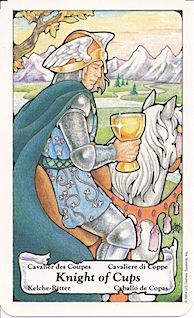
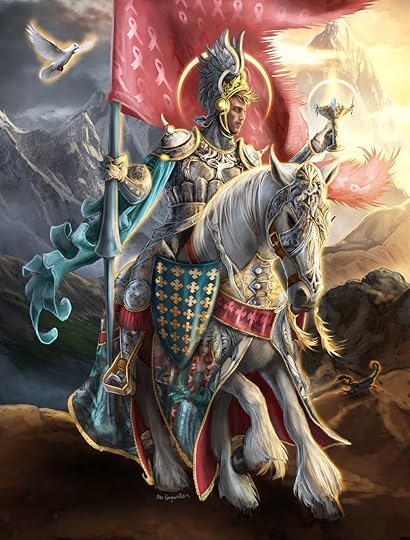
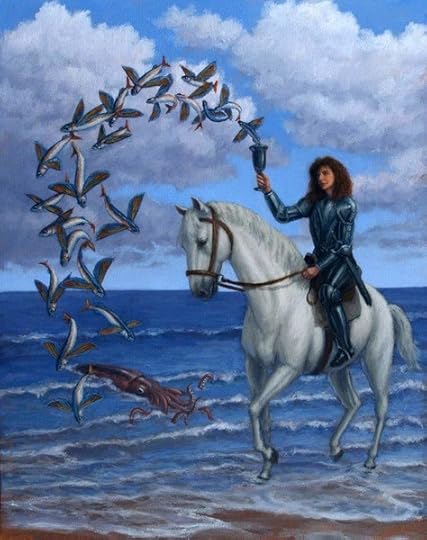
Here are some depictions of the knight - from reasonably traditional to reasonably way out. :)
Let me grab a bit of background from Wikipedia:
"The tarot (/ˈtæroʊ/; first known as trionfi and later as tarocchi, tarock, and others) is a pack of playing cards (most commonly numbering 78), used from the mid-15th century in various parts of Europe to play a group of card games such as Italian tarocchini and French tarot. From the late 18th century until the present time the tarot has also found use by mystics and occultists for divination.
Like the common deck of playing cards, the tarot has four suits (which vary by region, being the French suits in Northern Europe, the Latin suits in Southern Europe, and the German suits in Central Europe). Each of these suits has pip cards numbering from one (or Ace) to ten and four face cards (King, Queen, Knight, and Jack/Knave) for a total of 14 cards. In addition, the tarot has a separate 21-card trump suit and a single card known as the Fool. Depending on the game, the Fool may act as the top trump or may be played to avoid following suit.
François Rabelais gives tarau as the name of one of the games played by Gargantua in his Gargantua and Pantagruel; this is likely the earliest attestation of the French form of the name.
Tarot cards are used throughout much of Europe to play card games. [These game are not extensively played in English-speaking countries, where tarot cards are now used primarily for divinatory purposes.]
Occultists call the trump cards and the Fool "the major arcana" while the ten pip and four court cards in each suit are called minor arcana. The cards are traced by some occult writers to ancient Egypt or the Kabbalah but there is no documented evidence of such origins or of the usage of tarot for divination before the 18th century.
I myself own 2 or 3 tarot decks because of the interesting art work - they come in very interesting "styles".
The first story deals with the Knight of Cups. Let's see if we can find some interesting versions of that one.



Here are some depictions of the knight - from reasonably traditional to reasonably way out. :)
Suite of cups. Why the water theme in the image above? (I wondered myself - I'd become rusty on tarot symbology) - well, apparently the suite of cups stands representative of water and hence emotions.
I found an explanation online:
The Suit of Cups is representative of the element of water.
The Suit of Cups Tarot card meanings deal with the emotional level of consciousness and are associated with love, feelings, relationships and connections. Cups are about displays of emotion, expression of feelings and the role of emotions in relation to others. The Cups Tarot cards indicate that you are thinking with your heart rather than your head, and thus reflect your spontaneous responses and your habitual reactions to situations. Cups are also linked to creativity, romanticism, fantasy and imagination.
The negative aspects of the Suit of Cups (i.e. when the Cups cards appear reversed) include being overly emotional or completely disengaged and dispassionate, having unrealistic expectations and fantasising about what could be. There may be repressed emotions, an inability to truly express oneself and a lack of creativity.
The Suit of Cups traditionally represents the west and autumn. If using an ordinary deck of playing cards, Cups are represented by the Suit of Hearts.
..and per Wikipedia:
Additionally, cups were the symbol of the clergy in feudal times, and thus cup cards can also be interpreted as having to do with spiritual or religious matters.
The suit represents the First Estate (the Clergy).
..and specifically about knight of cups: Knight of Cups: A young man on a horse with a winged helmet offers a cup. The card can indicate a sensitive male, unmarried, a suitor who seeks the hand of a lady. He is honest and truthful, as well as is heartfelt. It can also indicate a matter of an emotional nature.
I found an explanation online:
The Suit of Cups is representative of the element of water.
The Suit of Cups Tarot card meanings deal with the emotional level of consciousness and are associated with love, feelings, relationships and connections. Cups are about displays of emotion, expression of feelings and the role of emotions in relation to others. The Cups Tarot cards indicate that you are thinking with your heart rather than your head, and thus reflect your spontaneous responses and your habitual reactions to situations. Cups are also linked to creativity, romanticism, fantasy and imagination.
The negative aspects of the Suit of Cups (i.e. when the Cups cards appear reversed) include being overly emotional or completely disengaged and dispassionate, having unrealistic expectations and fantasising about what could be. There may be repressed emotions, an inability to truly express oneself and a lack of creativity.
The Suit of Cups traditionally represents the west and autumn. If using an ordinary deck of playing cards, Cups are represented by the Suit of Hearts.
..and per Wikipedia:
Additionally, cups were the symbol of the clergy in feudal times, and thus cup cards can also be interpreted as having to do with spiritual or religious matters.
The suit represents the First Estate (the Clergy).
..and specifically about knight of cups: Knight of Cups: A young man on a horse with a winged helmet offers a cup. The card can indicate a sensitive male, unmarried, a suitor who seeks the hand of a lady. He is honest and truthful, as well as is heartfelt. It can also indicate a matter of an emotional nature.
Ok, next: king of coins. Hmm, let's just mention that there are 4 minor arcana, just as there are 4 suites in traditional playing cards. I'll do some more research, but I feel pretty sure that our usual 52- cards deck was derived from tarot cards.
Ah, yes, I'm right: The Minor Arcana (or Lesser Arcana) are the 56 suit cards of the 78-card deck of tarot playing cards. The Minor Arcana comprise four suits with 14 cards each. Although there are variations, the Minor Arcana commonly employ the Italo-Spanish suits: Wands (alternatively, batons, clubs, or staves), cups, swords, and pentacles (alternatively, coins, disks, or rings). In contrast, the French suits are spades (♠), hearts (♥), diamonds (♦) and clubs (♣).
Each Minor Arcana card in a suit is numbered one (ace) to ten, except for the court cards (or courts)—page, knight, queen, and king—which are comparable to face cards. In one variation, princess and prince cards replace the page and knight cards. Some Italian decks add two more court cards: the maid and the mounted lady.
Since contemporary decks of French playing cards replace both the knight and the page with the jack or knave, such decks only have 52 cards. The remaining 22 cards in a tarot deck are the Major Arcana. Traditionally, the Major Arcana are more significant, but the Minor Arcana are what allow Tarot readers to understand the subtleties and details that surround the major events and signifiers in a Tarot spread; in general, the Major Arcana represent large turning points and the Minor Arcana represent the day-to-day insights.[1]
Minor Arcana cards in contemporary tarot decks are usually illustrated—a convention popularized by the Rider-Waite tarot deck ca. 1910. Non-illustrated cards bear symmetrical arrangements of pips. [wikipedia]
Ah, yes, I'm right: The Minor Arcana (or Lesser Arcana) are the 56 suit cards of the 78-card deck of tarot playing cards. The Minor Arcana comprise four suits with 14 cards each. Although there are variations, the Minor Arcana commonly employ the Italo-Spanish suits: Wands (alternatively, batons, clubs, or staves), cups, swords, and pentacles (alternatively, coins, disks, or rings). In contrast, the French suits are spades (♠), hearts (♥), diamonds (♦) and clubs (♣).
Each Minor Arcana card in a suit is numbered one (ace) to ten, except for the court cards (or courts)—page, knight, queen, and king—which are comparable to face cards. In one variation, princess and prince cards replace the page and knight cards. Some Italian decks add two more court cards: the maid and the mounted lady.
Since contemporary decks of French playing cards replace both the knight and the page with the jack or knave, such decks only have 52 cards. The remaining 22 cards in a tarot deck are the Major Arcana. Traditionally, the Major Arcana are more significant, but the Minor Arcana are what allow Tarot readers to understand the subtleties and details that surround the major events and signifiers in a Tarot spread; in general, the Major Arcana represent large turning points and the Minor Arcana represent the day-to-day insights.[1]
Minor Arcana cards in contemporary tarot decks are usually illustrated—a convention popularized by the Rider-Waite tarot deck ca. 1910. Non-illustrated cards bear symmetrical arrangements of pips. [wikipedia]
Anyway, as I had wanted to say before becoming distracted, :P , about coins or pentacles; per Wikipedia :
It corresponds to the Suit of Diamonds in standard decks.
The suit represents the Third Estate (town-dwellers).
Also: The Suit of Pentacles (also known as Coins or Disks) is representative of the element of Earth. The Suit of Pentacles Tarot card meanings cover material aspects of life including work, business, trade, property, money and other material possessions. The positive aspects of the Suit of Pentacles include manifestation, realisation, proof and prosperity.
Hmm, these cards are darn complex if you want to "represent" yourself with them - for example, the first cup that the first traveler represents himself with, is an 'emotional' one do to with water, and the Clergy, but Calvino seemed to rather derive the attributes from what the illustration on the card looked like, since the attributes he seems to draw from it are "his wealthy station, his inclination toward luxury and prodigality" whereas, coins, rather than cups would appear to represent attributes such as wealth and luxury. I wonder why he is subverting the traditional meanings.
Maybe Disha can help us out with that...
Ah, okay, I suppose the knight of cups makes sense after all - the man is out adventuring and potentially looking for a wife. ;)
It corresponds to the Suit of Diamonds in standard decks.
The suit represents the Third Estate (town-dwellers).
Also: The Suit of Pentacles (also known as Coins or Disks) is representative of the element of Earth. The Suit of Pentacles Tarot card meanings cover material aspects of life including work, business, trade, property, money and other material possessions. The positive aspects of the Suit of Pentacles include manifestation, realisation, proof and prosperity.
Hmm, these cards are darn complex if you want to "represent" yourself with them - for example, the first cup that the first traveler represents himself with, is an 'emotional' one do to with water, and the Clergy, but Calvino seemed to rather derive the attributes from what the illustration on the card looked like, since the attributes he seems to draw from it are "his wealthy station, his inclination toward luxury and prodigality" whereas, coins, rather than cups would appear to represent attributes such as wealth and luxury. I wonder why he is subverting the traditional meanings.
Maybe Disha can help us out with that...
Ah, okay, I suppose the knight of cups makes sense after all - the man is out adventuring and potentially looking for a wife. ;)
King of coins:
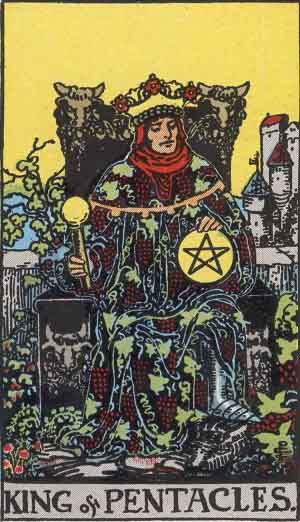 (I think this is that traditional Rider-Waite version. )
(I think this is that traditional Rider-Waite version. )


The King of Coins depicts a mature man of considerable earthly power, usually depicted as a diplomatic business-man with a lot of practical wisdom. The king of pentacles can be miserly at times. He has a taste for sensual delights and earthly gifts. Here is a man who has a social standing and is big on keeping up with the Joneses. On the downside, he can be a man of phenomenally huge ego, one who should not be crossed.
 (I think this is that traditional Rider-Waite version. )
(I think this is that traditional Rider-Waite version. )

The King of Coins depicts a mature man of considerable earthly power, usually depicted as a diplomatic business-man with a lot of practical wisdom. The king of pentacles can be miserly at times. He has a taste for sensual delights and earthly gifts. Here is a man who has a social standing and is big on keeping up with the Joneses. On the downside, he can be a man of phenomenally huge ego, one who should not be crossed.
Hanged man:


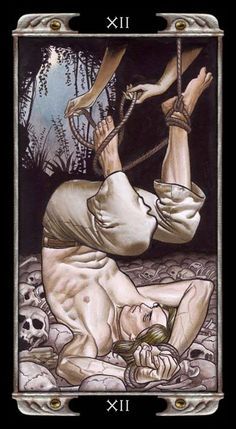
It originally depicted a pittura infamante , a shameful image of a traitor being punished in a manner common at the time for traitors in Italy. Some versions portray Judas, and include the bags of silver in his hands.
A 1393 decree for Milan and Lombardy of the punishment for traitors: “Let him be [dragged] on a [wooden] plank by a horse to the place of execution, and there be suspended by one foot to the gallows, and be left there until he is dead. As long as he lives let him be given food and drink.”
Modern versions of the tarot deck depict a man hanging upside-down by one foot. The figure is most often suspended from a wooden beam (as in a cross or gallows) or a tree. Ambiguity results from the fact that the card itself may be viewed inverted.
The Hanged Man is unsettling because it symbolizes paradox. The Hanged Man presents truths that are hidden in their opposites.



It originally depicted a pittura infamante , a shameful image of a traitor being punished in a manner common at the time for traitors in Italy. Some versions portray Judas, and include the bags of silver in his hands.
A 1393 decree for Milan and Lombardy of the punishment for traitors: “Let him be [dragged] on a [wooden] plank by a horse to the place of execution, and there be suspended by one foot to the gallows, and be left there until he is dead. As long as he lives let him be given food and drink.”
Modern versions of the tarot deck depict a man hanging upside-down by one foot. The figure is most often suspended from a wooden beam (as in a cross or gallows) or a tree. Ambiguity results from the fact that the card itself may be viewed inverted.
The Hanged Man is unsettling because it symbolizes paradox. The Hanged Man presents truths that are hidden in their opposites.
Hmm, I really liked the first story, but cannot help wondering how come the idiot Knight of Cups is still alive... ;) :P (If he'd been torn to pieces.)
Perhaps a better ending would have been for him to marry the dishonored Amazon and give their son a happy life? ...but maybe this knight does not have it in him, to be a good and honorable father and husband?
How about we do 2 or 3 stories per thread? Next thread here: https://www.goodreads.com/topic/show/...
Perhaps a better ending would have been for him to marry the dishonored Amazon and give their son a happy life? ...but maybe this knight does not have it in him, to be a good and honorable father and husband?
How about we do 2 or 3 stories per thread? Next thread here: https://www.goodreads.com/topic/show/...
Books mentioned in this topic
The Canterbury Tales (other topics)The Castle of Crossed Destinies (other topics)





Wandering guests gather in two locales that are the same locale, a castle and a tavern. Unable to speak, they tell their stories by means of Tarot cards, laid on the table.
This is Calvino's Tarot card experiment, in which he attempted to 'read' stories from the art on two different packs of Tarot cards, with intersecting stories reusing the cards from previous tales as the cards were laid on the table.
Was he successful?